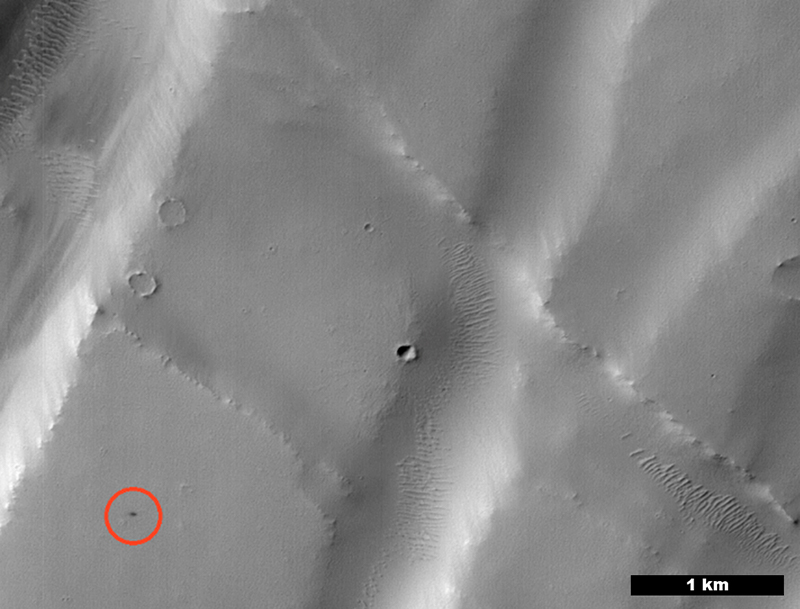PROVIDENCE, R.I. [Brown University] — Billions of years ago, flowing rivers and erupting volcanoes were the dominant processes that reshaped the surface of Mars. Today, those processes have ground to a halt, but that doesn’t mean the Martian surface is stagnant. A regular battering from small meteoroids continues to sculpt the Red Planet, and now NASA is using artificial intelligence (AI) to locate those fresh craters.
A new AI algorithm, developed at NASA’s Jet Propulsion Laboratory (JPL), pores through images taken by a satellite called the Mars Reconnaissance Orbiter (MRO), looking for tiny blotches and smudges that suggest an impact has taken place. This past August, the system notched its first confirmed catch — a cluster of small craters in a region called Noctis Fossae that appeared sometime between March 2010 and May 2012.
Ingrid Daubar, a senior research associate at Brown who also works at JPL, has studied fresh impacts on Mars for years. She and two Brown undergraduate students, Annabelle Gao and Daniel Wexler, are working with JPL’s AI team on the project. The hope is that automation may speed the discovery of new impacts on Mars, and there are plenty of reasons to be interested in fresh craters, Dauber says.
“They provide us with a window into the subsurface,” she said. “Some of these fresh impacts have actually exposed subsurface water ice, for example.”
Finding fresh craters also lets scientists calculate the present impact flux on Mars. Scientists use the number and size of craters to establish ages for exposed Martian surfaces, so a better idea of the present flux rate could make for better dating. The flux rate also helps in calculating the hazards associated with future exploration.
For the AI project, Daubar provided images of fresh craters that researchers already knew about in order to train the AI classifier on what to look for. After training, the JPL team turned the classifier loose on 112,000 pictures taken by the MRO’s Context Camera, which captures vast swaths of the Martian landscape at relatively low resolution. The classifier then returned a list of potential possible craters with varying degrees of confidence, which researchers could then verify as craters or not.

One of the high-confidence spots the classifier flagged was the crater cluster at Noctis Fossae. But there are still many more crater candidates that need human verification, and that’s what Gao and Wexler, both of whom are considering concentrations in the Department of Earth, Environmental and Planetary Sciences, have been doing for the past few months.
“There’s a whole smorgasbord of things provided by the classifier, and we’re trying to work through all of those to find which ones are actually new craters,” Wexler said.
Sometimes the classifier flags things that aren’t craters at all, Wexler says. Sometimes they are craters, but they’re ones that researchers already knew about. Other times, there may not be adequate before-and-after images to confirm that the craters are fresh.
“But a good number of them do turn out to be new craters that we haven’t found before,” Wexler said. “It’s always exciting when you find one of those.”
In order to do the work, Gao and Wexler needed to become expert crater hunters themselves, which they did in collaboration with Daubar.
“What we’re looking for is the ejecta around the crater,” Gao said. “When an impactor comes in, it sprays dust out from the crater that’s a little darker than the dust on the surface. That’s what we’re looking for.”
It’s not always clear from the low-resolution Context Camera images whether what they’re seeing is a crater or not. When they’re not sure, Gao and Wexler can put in a request to have the spot imaged by another MRO camera called HiRISE, which takes images at stunningly high resolution. They enter their request through a portal called HiWish, which enables researchers and the general public alike to request images of particular spots on Mars.
“They make it easy to enter a request, and I think it’s really great that anyone can do it,” Gao said. “That’s my shameless plug for HiWish.”
Wexler and Gao have a number of HiWish requests pending now, and they’re looking forward to seeing if those requests yield new craters.
For her part, Daubar says she’s looking forward to delving into the characteristics of this new batch of AI-discovered craters.
“I think it’s going to be really interesting to see if the AI algorithm is finding craters in different places or of different sizes, or if there’s some other characteristic that makes them harder for humans to find,” she said. “And once we have that integrated dataset, will it tell us something new about Mars? That’s really the fun part.”
Both Gao and Wexler said that they never expected when they came to Brown that they’d end up hunting for craters on another world, but both say they’re glad they got the opportunity.
“It’s just a really cool thing to be a part of,” Gao said.